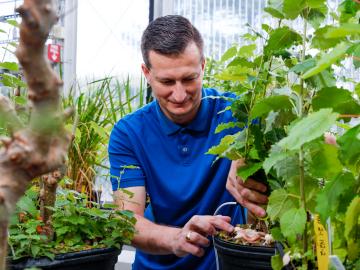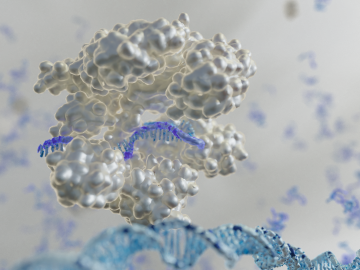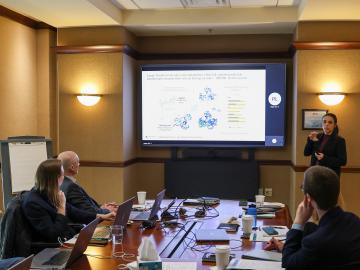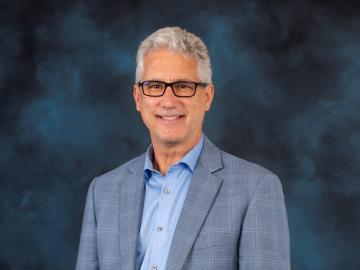Filter News
Area of Research
News Topics
- (-) Biotechnology (37)
- (-) Irradiation (3)
- 3-D Printing/Advanced Manufacturing (144)
- Advanced Reactors (40)
- Artificial Intelligence (125)
- Big Data (77)
- Bioenergy (110)
- Biology (126)
- Biomedical (73)
- Buildings (73)
- Chemical Sciences (84)
- Clean Water (32)
- Composites (34)
- Computer Science (223)
- Coronavirus (48)
- Critical Materials (29)
- Cybersecurity (35)
- Education (5)
- Element Discovery (1)
- Emergency (4)
- Energy Storage (114)
- Environment (217)
- Exascale Computing (64)
- Fossil Energy (8)
- Frontier (62)
- Fusion (65)
- Grid (74)
- High-Performance Computing (128)
- Hydropower (12)
- Isotopes (62)
- ITER (9)
- Machine Learning (67)
- Materials (156)
- Materials Science (156)
- Mathematics (12)
- Mercury (12)
- Microelectronics (4)
- Microscopy (56)
- Molten Salt (10)
- Nanotechnology (62)
- National Security (86)
- Neutron Science (169)
- Nuclear Energy (121)
- Partnerships (66)
- Physics (68)
- Polymers (35)
- Quantum Computing (52)
- Quantum Science (88)
- Security (30)
- Simulation (64)
- Software (1)
- Space Exploration (26)
- Statistics (4)
- Summit (70)
- Transportation (102)
Media Contacts

Jesse Labbé aims to leverage biology, computation and engineering to address societal challenges related to energy, national security and health, while enhancing U.S. competitiveness. Labbé emphasizes the importance of translating groundbreaking research into practical applications that have real-world impact.

Scientists at Oak Ridge National Laboratory and the University of Colorado Boulder used a gene-silencing tool and a large library of molecular guides to understand how photosynthetic bacteria adapt to light and temperature changes. They found that even partial suppression of certain genes yielded big benefits in modifying the stress response of wild microbes.
Vilmos Kertesz, senior staff in the Biosciences Division at ORNL, has received a 2025 Al Yergey Mass Spectrometry Scientist Award from the American Society for Mass Spectrometry. The award recognizes his contributions to the fields of analytical chemistry and mass spectrometry.
Robert “Bob” Hettich, an ORNL Corporate Fellow, is a pioneer in using mass spectrometry to uncover how microbes interact within complex environments and influence larger systems like plants and humans. A founder of the field of metaproteomics, he leads research that supports bioenergy, environmental resilience and health through advanced protein analysis.

Scientists at the Department of Energy’s Oak Ridge National Laboratory recently welcomed Vanderbilt University colleagues for a symposium on basic science research, with a focus on potential collaborations in the biomedical and biotechnology spaces.

Gerald Tuskan, director of the Center for Bioenergy Innovation and a Corporate Fellow at ORNL, has been awarded the Marcus Wallenberg Prize, the world’s highest honor in the field of forestry, for his pioneering work in sequencing and analyzing the first tree genome.
Daniel Jacobson, distinguished research scientist in the Biosciences Division at ORNL, has been elected a Fellow of the American Institute for Medical and Biological Engineering, or AIMBE, for his achievements in computational biology.

Scientists at ORNL have developed a first-ever method of detecting ribonucleic acid, or RNA, inside plant cells using a technique that results in a visible fluorescent signal. The technology can help researchers detect and track changes in RNA and gene expression in real time, providing a powerful tool for the development of hardier bioenergy and food crops and for detection of unwanted plant modifications, pathogens and pests.
Scientists at ORNL and the University of Cincinnati achieved a breakthrough in understanding the vulnerability of microbes to the butanol they produce during fermentation of plant biomass. The discovery could pave the way for more efficient production of domestic fuels, chemicals and materials.

In collaboration with the U.S. Department of Homeland Security’s Science and Technology Directorate, researchers at ORNL are evaluating technology to detect compounds emitted by pathogens and pests in agricultural products at the nation’s border.


